Documents: Go to download!
User Manual
- User Manual - (English)
- Product Information Sheet - (English)
- Installation Intructions - (English)
- Getting to know your appliance
- Gas burners
- Settings table and tips
- Cleaning and maintenance
- Trouble shooting
- Customer service
Table of contents
User manual Gas Cooktop
Getting to know your appliance
Burner locations
PPS9A6B90A
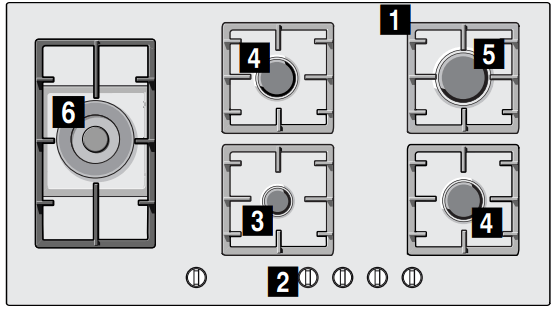
- Pan supports
- Control knobs
- Economy burner with an output of up to 1 kW
- Standard-output burner with an output of up to 1.75 kW
- High-output burner with an output of up to 3 kW
- Wok burner with an output of up to 4 kW
Controls and burners
Each control knob is marked with the burner it controls. You can use the control knobs to set the output required in each case to various positions between the maximum and the minimum settings. Never try to switch directly from position 0 to position 1 or from position 1 to position 0.

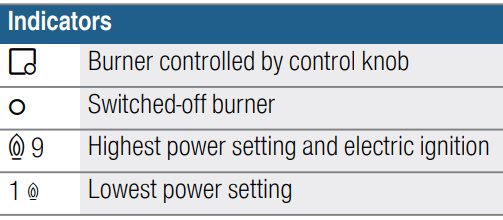
It is essential to ensure that all the burner parts and pan supports are correctly installed for the appliance to work correctly. Do not swap the burner caps around.
Always remove the pan supports carefully. When moving a pan support, the pan supports next to it may also move.

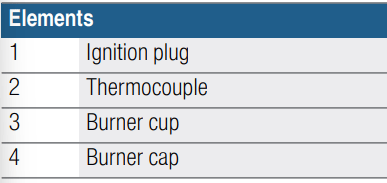
Accessories
Depending on the model, the hob may include the following accessories. These can also be acquired from the Technical Assistance Service.
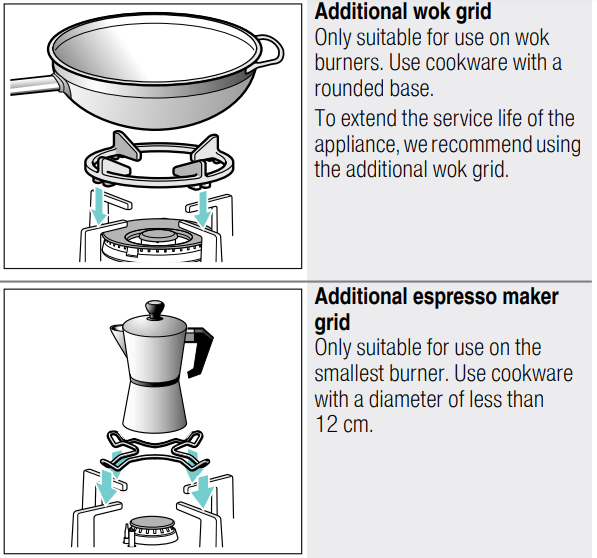
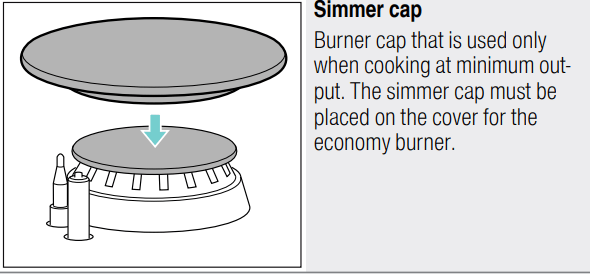
Code
HEZ298126 Additional wok grid: Cast iron (mini wok burner)
HEZ298127 Additional wok grid: Cast iron (4-5 kW)
HEZ298110 Additional wok grid: Enamelled steel
HEZ298114 Additional espresso maker grid
HEZ211310 Simmer cap
The manufacturer accepts no liability if these accessories are not used or are used incorrectly.
Gas burners
Switching on manually
- Press the control knob for the selected burner and turn it anticlockwise to the highest power setting.
- Hold an igniter or a naked flame (such as a lighter or a match) against the burner.
Automatic ignition
If your appliance has automatic ignition (ignition plugs):
- Press the control knob for the selected burner and turn it anticlockwise to the highest power setting. Sparks are produced on all burners while you are pressing and holding the control knob. The burner ignites.
- Release the control knob.
- Turn the control knob to the required position.
If the burner does not ignite, switch it off and repeat the steps described above. This time, hold the control knob down for longer (up to 10 seconds).
Warning – Risk of deflagration!
If the burner does not switch on after 15 seconds, switch off the control knob and open the door or window in the room. Wait at least a minute before igniting the burner again.
Note: It is important to keep the appliance clean. If the ignition plugs are dirty, this may cause ignition faults. Clean the ignition plugs regularly with a small nonmetallic brush. Take care to prevent the ignition plugs from suffering any heavy knocks.
Safety system
Your hob is equipped with a safety system (thermocouple) that cuts off the gas when the burners are accidentally switched off.
To ensure that this device is active:
- Switch on the burner as usual.
- Without releasing the control knob, press and hold it down firmly for 4 seconds after lighting the flame.
Switching off a burner
Turn the corresponding control knob clockwise to the 0 setting.
A few seconds after the burner is switched off, a sound (thud) will be produced. This is not a fault - this means that the safety device is no longer operating.
Warnings
It is normal to hear a soft whistling noise while the burner is operating.
When first used, it is normal for the burner to give off odours. This does not pose any risk and does not indicate a malfunction. They will disappear in time.
An orange-coloured flame is normal. This is caused by the presence of dust in the atmosphere, spilt liquids, etc.
If the burner flames are accidentally blown out, switch off the burner operating control knob and do not try to relight it for at least 1 minute.
Settings table and tips
Suitable pans

The cookware must not overhang the edge of the hob.
Precautions for use
The following advice is intended to help you save energy and prevent pan damage:

Use pans which are the right size for each burner. Do not use small pans on large burners. The flame must not touch the sides of the pan.

Do not use damaged pans, which do not sit evenly on the hob. Pans may tip over. Only use pans with a thick, flat base.
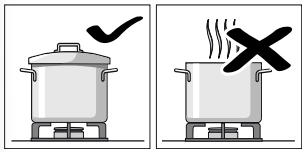
Do not cook without using a lid and make sure the lid is properly fitted. This wastes energy.
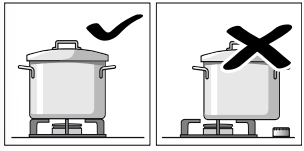
Always centre the pan over the burner, not to one side. Otherwise it could tip over. Do not place large pans on the burners near the control knobs. These may be damaged by the very high temperatures.
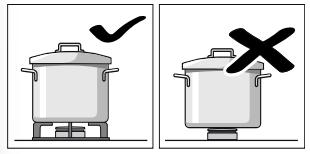
Place the pans on the pan supports, never directly on the burner. Make sure that the pan supports and burner caps are correctly positioned before using the appliance.
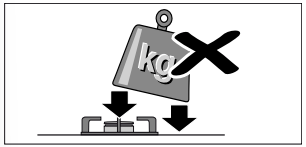
Pans should be placed on the hob carefully. Do not strike the hob and do not place excessive weight on it.
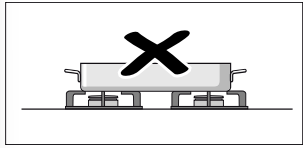
Never use two burners or heat sources to heat one single pan. Do not use grill pans, earthenware casserole dishes, etc. for a long period of time on maximum power.
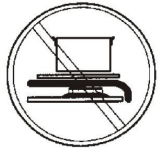
Do not place anything, eg. flame tamer, asbestos mat, between pan and pan support as serious damage to the appliance may result.
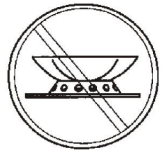
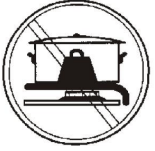
Do not use large pots or heavy weights which can bend the pan support or deflect flame onto the hotplate.
Table of cooking times
The table below lists the optimal heat settings and cooking times for various types of food. The information given applies when cooking four portions.
The cooking times and heat settings may vary depending on the type of food, its weight and quality, on the type of gas used, and on the material from which the cookware is made. To prepare this dish, stainless steel cookware was mainly used.
Always use cookware that is the right size and place it in the centre of the burner. You can find information about the diameter of the cookware under → "Suitable pans"
Information on the table
Each type of food can be prepared in one or two steps. Each step contains information about the following:
 Cooking method
Cooking method
 Heat setting
Heat setting
 Cooking time in minutes
Cooking time in minutes
Cooking methods featured in the table
 Bringing to the boil
Bringing to the boil
 Continuing cooking
Continuing cooking
 Building up pressure in the pressure cooker
Building up pressure in the pressure cooker
 Maintaining pressure in the pressure cooker
Maintaining pressure in the pressure cooker
 Frying on high heat
Frying on high heat
 Frying gently
Frying gently
 Melting, liquefying
Melting, liquefying
* Without lid
** Stirring constantly
Note: The symbols do not appear on the appliance. They are used here to represent the various cooking methods.
Information on how to cook food on the different burners is displayed. We recommend using the first burner that was mentioned. The model overview describes all of the burners on the hob.
Example:
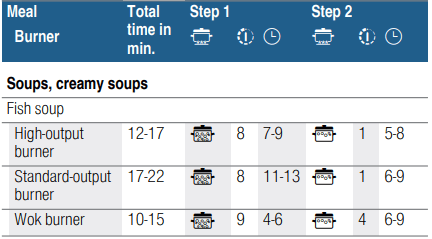
This example shows the preparation of fish soup using the high-output burner, the standard-output burner and the wok burner.
When using the high-output burner (recommended option), the total cooking time is between 12 and 17 minutes.
■ Step 1: Bring to the boil. Set heat setting 8 for 7-9 minutes.
■ Step 2: Continue boiling. Switch to heat setting 1 for 5-8 minutes.
This information also applies for the other suggested burners.
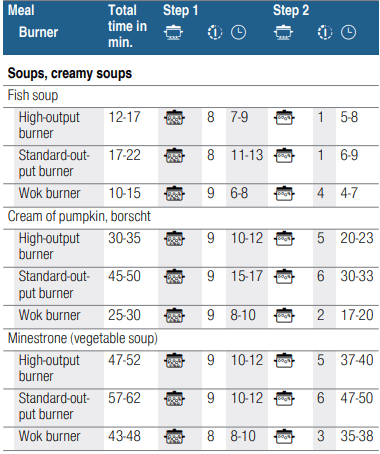

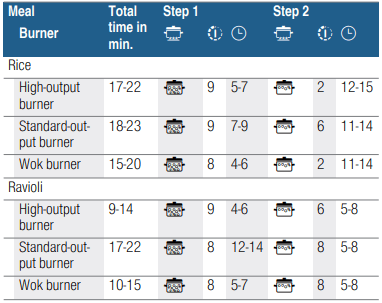
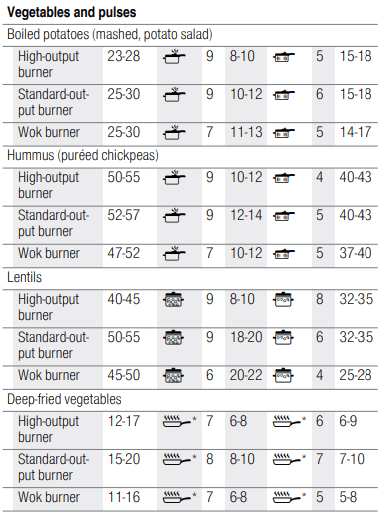

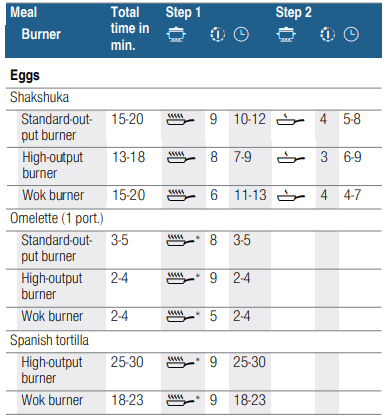
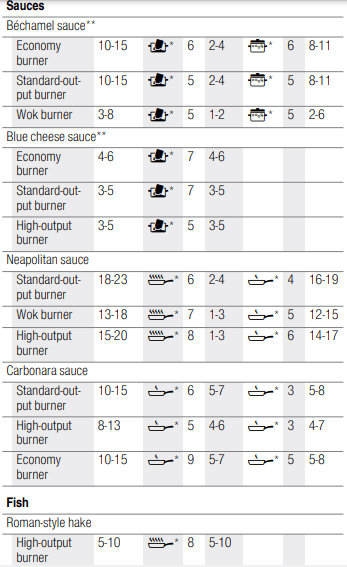
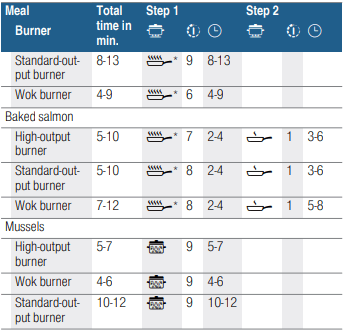

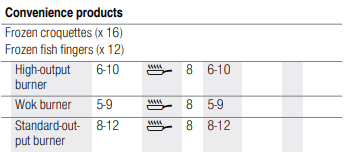

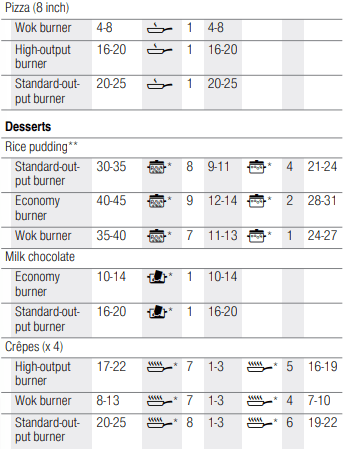
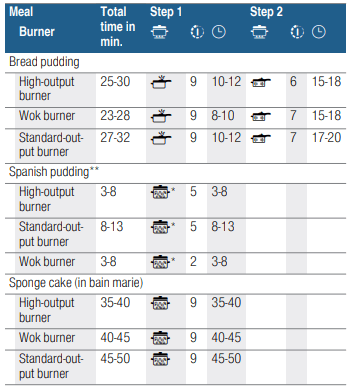
Cooking tips
■ Use a pressure cooker to cook creamy soups and pulses. This significantly reduces the cooking time. If you are using a pressure cooker, follow the manufacturer's instructions. Add all of the ingredients at the start.
■ Always use a lid when cooking potatoes and rice. This significantly reduces the cooking time. The water must be boiling before you add pasta, rice or potatoes. Then adjust the heat setting to continue boiling.
■ For pan-cooked dishes, heat the oil up first. As soon as you have started the frying, keep the pan at a constant temperature by adjusting the heating setting as required. When preparing several portions, wait until the relevant temperature has been reached again. Turn the food regularly.
■ When cooking soups, cream, lentils or chickpeas, add all of the ingredients to the cookware at the same time.
Cleaning and maintenance
Cleaning
Once the appliance is cool, use a sponge to clean it with soap and water.
After each use, clean the surface of the respective burner parts once they have cooled down. If any residue is left (baked-on food, drops of grease etc.), however little, it will become stuck to the surface and more difficult to remove later. The holes and grooves must be clean for the flame to ignite properly.
The movement of some pans may leave metal residue on the pan supports.
Clean the burners and pan supports using soapy water and scrub with a non-wire brush.
If the pan supports are fitted with rubber rests, ensure that these are also cleaned. The rests may come loose and the pan support may scratch the hob.
Always dry the burners and pan supports completely. Water droplets or damp patches on the hob at the start of cooking may damage the enamel.
After cleaning and drying the burners, make sure the burner caps are correctly positioned on the diffuser.
Caution!
■ Do not remove the control elements when cleaning the appliance. The appliance may be damaged if moisture finds its way inside.
■ Do not use steam cleaners. This could damage the hob.
■ Never use abrasive products, steel scourers, sharp implements, knives, etc. to remove bits of hardened food from the hob.
■ Do not use knives, scrapers or similar implements to clean the point where the glass meets the burner trims, the metal frames or the glass/aluminium panels, if fitted.
Maintenance
Always clean off any liquid as soon as it is spilt. This will prevent food remains from sticking to the hob surface and you will save yourself any unnecessary effort.
Never slide pans across the glass surface, as you may scratch it. In addition, try not to drop heavy or sharp objects on the glass. Never strike any part of the hob.
Grains of sand that may come from cleaning fruits and vegetables will scratch the glass surface.
Melted sugar, or foods which contain a lot of sugar which may have spilt, should be cleaned off the hotplate immediately, using the glass scraper.
Trouble shooting
DO NOT MODIFY THIS APPLIANCE.
Only authorized personnel from the Service Centre are qualified to work on the appliance.
Sometimes certain faults detected can be easily resolved. Before calling the Technical Assistance Service, bear in mind the following advice:
Fault | Possible cause | Solution |
| The general electrical system is malfunctioning. | Defective fuse. | Check the fuse in the main fuse box and change it if it is damaged. |
| The automatic safety switch or circuit breaker has tripped. | Check the main control panel to see if the automatic safety switch or circuit breaker has tripped. | |
| The automatic switching on function does not work. | There may be food or cleaning products stuck between the ignition sparkers and the burners. | The space between the ignition sparker and the burner must be clean. |
| The burners are wet. | Dry the burner caps carefully. | |
| The burner caps are not correctly positioned. | Check that the burner caps are correctly positioned. | |
| The appliance is not earthed, is poorly connected or the earthing is faulty. | Contact the installation technician. | |
| The burner flame is not uniform. | The burner components are not correctly positioned. | Correctly place the parts on the appropriate burner. |
| The grooves on the burner are dirty. | Clean the grooves on the burner. | |
| The gas flow is not normal or there is no gas. | The gas supply is blocked by gas taps. | Open all gas taps. |
| If the gas is supplied from a gas cylinder, check that it is not empty. | Change the gas cylinder. | |
| The kitchen smells of gas. | A gas tap has been left on. | Turn off the taps. |
| Incorrect coupling of gas cylinder. | Check that the coupling is sound. | |
| Possible gas leak. | Shut off the gas supply, ventilate the premises and immediately notify an authorised installation technician to check and certify the installation. Do not use the appliance until ensuring that there is no gas leak in the installation or appliance itself. | |
| The burner immediately switches off after releasing the control knob. | The control knob was not held down for long enough. | Once the burner is on, hold the control knob down a few seconds longer. |
| The grooves on the burner are dirty. | Clean the grooves on the burner. |
Any of the following are considered to be abnormal operation and may require servicing:
■ Yellow tipping of the cooktop burner flame.
■ Sooting up of cooking utensils.
■ Burners not lighting properly.
Gas valves, which are difficult to turn in case the appliance fails to operate correctly, contact the authorised service provider in your area.
Customer service
When contacting our Technical Assistance Service, please provide the product number (E-Nr.) and production number (FD) of the appliance. This information is given on the specifications plate located on the lower section of the hob and on the label in the user manual.
After-sales contact details for all countries can be found in the attached after-sales service directory.
Warranty conditions
In the unlikely event that the appliance is damaged or does not meet your expectations in terms of quality, please inform us as soon as possible. For the warranty to be valid, the appliance must not have been tampered with, or used inappropriately.
The applicable warranty conditions are those set out by the company's representative office in the country of purchase. Detailed information is available from retail outlets. Proof of purchase must be presented to obtain the benefits of the warranty.
We reserve the right to introduce changes.
See other models: PIJ611BB1E PIE631FB1E PVS675FB1E PXE651FC1E PVS875FB1E
